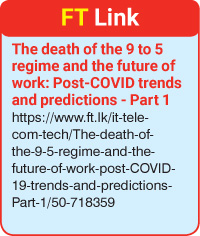Sunday Jan 18, 2026
Sunday Jan 18, 2026
Wednesday, 23 June 2021 00:03 - - {{hitsCtrl.values.hits}}
|
Sysco LABS General Manager Rasika Karunatilake
|
In the wake of COVID-19, most organisations have to confront a new normal; the death of the 9 to 5 regime – with indications of never returning to this scenario – forcing a reset of major work trends in a post-pandemic world.
This four-part serialised article delves into the future of work and emerging trends with fresh insight on the impact it is likely to have on us all.
While Part 1 looked at the challenges in remote working, Part 2 addresses the blurring lines between work life and home.
For many employees, the most significant realisation during the pandemic has been a newfound desire for social interaction and the intrinsic value of work amidst pandemic-related restrictions. With the initial euphoria of remote working wearing off, mental health and loneliness has begun to take its toll and led to employer’s having an expanded role as a social safety net, ensuring financial, physical and mental wellbeing, with leaders and HR cognisant of personal needs. However, amidst the enormous stresses of the crisis, future employees will judge employers on how convincingly employees are empowered, valued, and supported as people, not just as workers.
3. Intrinsic value of work
One of the most significant realisations brought about by the pandemic and its associated restrictions has been that people have become aware of the intrinsic value of work. Although workplace surveys indicate that the majority of people appear to prefer working from home, there are also others who are intrinsically motivated to return to office. By working from home people have enjoyed many extrinsic economic benefits. There has been an exodus from expensive cities to the suburbs and countryside, with many people opting for the peace and tranquillity that rural life brings.
The latter has resulted in increased savings pertaining to travel, accommodation, food and wardrobe costs. Top-tier companies have also ramped up healthcare benefits and provided other allowances to compensate towards working from home.
Notwithstanding these numerous advantages, people still feel that there is an emptiness in their lives. Working from a physical office space leads to variety and change; face-to-face interaction leads to fulfilment with respect to many intrinsic factors vis-à-vis feeling respected, having work recognised, opportunities for personal development and the ability to help work colleagues, all of which contribute towards satisfaction and self-actualisation.
4. Mental health and the loneliness epidemic
COVID-19 has made many people more anxious about their own personal safety and that of their families. For some, however, the pandemic has sparked more serious mental health issues which may prevail in the long-term. OCD, chronic loneliness brought about by social isolation and a general lack of meaning in life, are predicted to be the long-term mental health issues emanating from the pandemic.
Organisations can consider implementing awareness programmes on mental health and scrupulously check on associate wellbeing; also, employees will need to be able to solicit in-house or external professional mental health services as an extension of healthcare benefits. HR business partners will have a crucial role to play in ensuring that affected employees are provided the required support. Talent leaders will also need to demonstrate more empathy and be more cognisant about the personal lives and circumstances of their employees.
5. Expanded employer role as a safety net
The current economic crisis has pushed the boundaries in terms of the employee experience as personal factors take precedence. We have witnessed an increasing trend of employers paying greater attention to the financial, physical and mental well-being of their employees. Here are a few key benefits that top-tier companies offer their employees:
 6. Emergence of new top tier employers
6. Emergence of new top tier employers
While some organisations recognised the humanitarian crisis brought about by the pandemic and prioritised the wellbeing of their staff, others pushed employees to work in unsafe or high-risk conditions with little support. Many companies were compelled to effect pay cuts and prune down on benefits, and millions of workers also lost their jobs due to lay-offs and furloughs as the pandemic wreaked havoc in 2020.
Employees and prospective candidates will perforce judge organisations by the way they treated their employees during the pandemic. While some organisations ameliorated the suffering brought about by the pandemic and prioritised the wellbeing of employees, others pushed their staff to work in sub-optimal conditions.
The more prudent employers have implemented rigorous workplace health and safety practices and have taken pains to ensure employee wellbeing. Organisations that brought about pay-cuts will need to communicate clearly and candidly in order to win employee trust and minimise voluntary attrition. The effect on employee experience and company brand will be long lasting and will separate top tier employers from the rest.
(About the Author: Rasika Karunatilake is the General Manager at Sysco LABS – the technology innovation arm of Sysco Corporation (NYSE: SYY). Sysco Corporation is the global leader in selling, marketing, and distributing food products, equipment and supplies to the foodservice and hospitality industries. He counts 22 years of experience in the tech industry and is championing ‘Future of work’ initiatives at Sysco LABS. He can be contacted at [email protected])